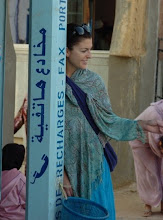We have been at the University all day today, so nothing new to report. But, we did have the standard three hour Arabic class this morning. Then, we had three hours of lectures afterward.
Since I have nothing exciting about today in particular, I decided to elaborate on some things that I have already posted, and some new information that I came across today.
In the last two posts, there are reference to North African Musicians. In fact, there is a video too. In Morocco, they are members of a group referred to as the Gnawa (or Gnaoua in French). The reason the French/English spelling is always different is that these words are obviously Arabic words, and there is no specific way of writing the transliteration because there are letters and sounds that are specific to the Arabic language. Each language then, takes its own alphabet and phonetics to spell the words trans-literally.
So, the Gnaoua are the very dark-skinned people that you see in the pictures and videos below. As I have mentioned before, the racial and ethnic population of Morocco is so diverse that there is no one way to tell who is Moroccan and who is not. The Gnaouans are no exception. Their name comes from the Tamazigh word for "black" which is Agnaw. They call themselves Sudanese, which also refers to black, or dark-skinned people as well, rather than the country that we now know as Sudan. Their origins in Morocco are from the Trans-Saharan slave trade, instituted by the great king, Moulay Ismail, who ruled from 1680-1728.
Moulay Ismail's rule coincided with the height of Absolute Monarchy in Europe (and Africa), and Moulay Ismail imported some tactics of ruling his empire from the practices of the Ottoman Empire. One of these tactics was the use of Janissaries. In the Ottoman empire, these were young Christian boys who were kidnapped and brought to court to be educated in either civil administration or military science. The idea was that these children would have no emotional ties to their homelands and serve as ideal civil administrators or in the standing armies of the powerful empires of the time.
Moulay Ismail empoyed the same tactics in Morocco, but with a shortage of Christian boys, he turned to kidnapping Muslim Moroccan boys from the Saharan Oases. He typically chose boys with dark skin until he experienced opposition from Moroccans, at which point he turned to lands south of Morocco. These countries included Senegal and Mali, where very dark skinned children were brought to be educated in Morocco. Most were Sufis who practiced the form of Islamic mysticism that is very popular in areas in Western Africa.

In the late 1600's and early 1700's, they were part of Moulay Ismail's standing army. Today, their children are known for their musical tradition and link to the spirit world that is associated with Sufism. Their role in Moroccan society today is twofold. One is that they are musicians who play the Sufi music that they brought with them from Mali and Senegal. The second is their role as Ma'lem, or spirit doctors who diagnose conditions where spirits or djinn have possessed people (mostly women), and perform exorcisms.
The exorcism ceremony is interesting because it includes the use of the musical performances that have become popular displays for tourists. After a woman has been diagnosed by the Ma'lem, the musicians will arrange a time for the ceremony and the woman will invite her close female friends and relatives to her home. No men are present during the ceremony, except the musicians and the Ma'lem. The Ma'lem tell the woman what color she can and cannot wear because the spirits are color-sensitive. Music is played and the woman goes into a trance at which point the spirit is invited to leave.
There are entire studies on Sufism that I am excited to delve into after my research on gender roles is complete. But, these are just some interesting details that were really helpful in understanding these people, their music and their ancestry. Now, perhaps, if you go back and look at the video, it will have a new meaning for you, as it did to me.

No comments:
Post a Comment